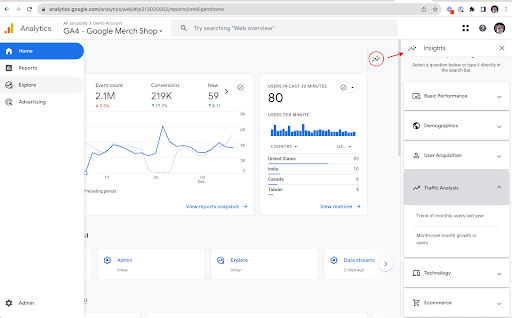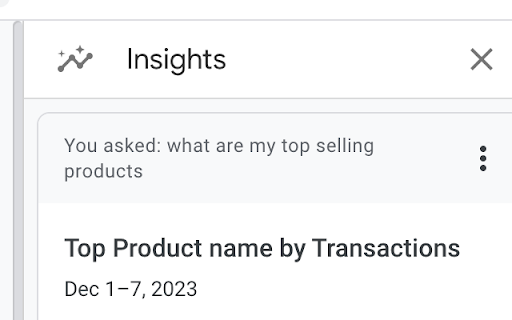AI-powered insights and predictive analytics are revolutionary tools reshaping the modern marketing landscape. These advanced analytics techniques, particularly prominent in Google Analytics 4 (GA4), can transform raw data into actionable insights. This article aims to demystify these complex concepts and provide a practical guide on utilizing them effectively to supercharge your marketing strategies. From predicting customer behavior to delivering personalized experiences, we’ll delve into the myriad of possibilities these cutting-edge technologies unlock. Let’s embark on this journey to unravel the exciting potential of AI and predictive analytics in GA4.
What Are AI-Powered Insights and Predictive Analytics?
Before we get too deep, let’s look at what AI-powered insights and predictive analytics are. They are like a crystal ball that can predict the future, but they use math and computers instead of magic. GA4 uses them like this:
- AI-Powered Insights: Have you ever wished for a super-smart friend who could tell you interesting things about your website visitors? That’s what AI-powered insights do. They look at all the data about people visiting a website and find unusual changes or patterns that might be important. For example, they might notice that more people visit the website from a particular city or at a specific time.
- Predictive Analytics: Now, imagine if that super-smart friend could also make educated guesses about what might happen in the future. That’s predictive analytics. GA4 uses this to learn more about customers by collecting structured event data. For example, it might predict that if someone visits a particular page on a website, they will likely come back and buy something later.
These tools are like opening a book full of stories about what your website visitors might do in the future. To be more precise, here’s where you can find these tools in GA4:
- AI-Powered Insights: First, log into your GA4 account. In the upper-right corner, click on ‘Insights’. Here, you’ll find automated insights generated by AI.

- Predictive Analytics: In the same left-hand menu, click on ‘Exploration.’ Here, you can create various reports using predictive metrics. In these reports, you can select predictive metrics such as ‘Purchase Probability’ or ‘Churn Probability.’

- You must ensure you have the proper setup to activate the predictive analytics in GA4. Predictive metrics in GA4 are based on your collected data, and specific requirements must be met to be available.
- Data Volume: You need a sufficient volume of data for GA4 to generate predictive metrics. Specifically, your property should have at least 30 days of data and 1000 positive examples of the outcomes you’re trying to predict.
- Event Setup: Your GA4 property needs to collect the specific events based on which the predictive metrics are based. For purchase probability, the ‘purchase’ event needs to be set up.
- Wait for Data Processing: Predictive metrics are updated daily, but changes can take up to 48 hours to appear in your reports.
If your predictive metrics are grayed out even after checking these factors, it could be due to an issue with your setup or a need for more sufficient data. You should contact Google Analytics support or your analytics partner for further assistance in such cases.
AI-powered insights and predictive analytics in GA4 are like having a super-smart friend who helps you understand your website visitors better and make intelligent predictions about what they’ll do next.
The Power of Combining AI-Powered Insights and Predictive Analytics
Combining AI-powered insights with predictive analytics can significantly elevate your understanding of customer behavior and help you make informed decisions about your website’s design and functionality. When these two powerful tools are utilized in tandem, they form a potent mix that can provide comprehensive insights into past behaviors, current trends, and future possibilities. For instance, by understanding the patterns of your website visits, the most visited pages, and the peak visit times, you can tailor your content to meet the needs and preferences of your audience. At the same time, predictive analytics can help forecast future customer behaviors, enabling you to design a user journey that optimizes engagement and conversion rates. Therefore, the fusion of AI-powered insights and predictive analytics can lead to enhanced user experience and improved retention rates, resulting in your website’s increased growth and success.
Using AI-Powered Insights and Predictive Analytics: A Practical Example
Imagine you run an online clothing store and want to optimize your sales for the upcoming holiday season. You can gain a competitive edge by using AI-powered insights and predictive analytics.
First, AI-powered insights can help you understand the current behavior of your customers. For instance, you can identify which items are the most popular, which pages are visited frequently, and what times of the day have the highest traffic. You might discover that athletic wear is the most popular category and that most visits happen late in the evening.

Second, predictive analytics can help forecast future customer behaviors. Using historical data, it can predict the likely customer demands during the holiday season. Based on last year’s data, there might be a surge in demand for sweaters and jackets.
By combining these two tools, you can make strategic decisions. For example, considering the insights, you can schedule your marketing emails and social media posts when your customers are most active online. You could also consider collaborating with fitness influencers to promote your athletic wear. Predictive analytics can guide you to stock up on sweaters and jackets before the holiday season to meet anticipated demand.
By leveraging AI-powered insights and predictive analytics, you can effectively cater to your customers’ needs, increase engagement, and drive more sales for your online store.
Case Studies: Harnessing AI-powered Insights and Predictive Analytics in Business
Let’s explore real-world examples of companies leveraging AI-powered insights and predictive analytics.
- Amazon: A titan in the e-commerce sector, Amazon uses predictive analytics to recommend products based on browsing and purchasing patterns to its customers. Coupled with AI technology, Amazon has personalized the shopping experience for each user, resulting in increased customer satisfaction and sales.
- Netflix: The global streaming service Netflix uses AI and predictive analytics to suggest shows and movies to its subscribers. By studying user behavior, viewing patterns, and preferences, Netflix can predict what a user is likely to watch next and personalize its recommendations, keeping subscribers engaged and reducing churn.
- Starbucks: Starbucks uses predictive analytics and AI to send personalized offers to its customers. Their AI tool, dubbed “Deep Brew,” analyzes customer preferences, purchase history, time of day, and even the weather to predict what customers are likely to order and to generate tailored marketing messages.
- American Express: American Express uses AI and predictive analytics to detect fraudulent transactions. By analyzing patterns in customer spending behavior, their system can flag potential fraud in real-time, thereby enhancing security for its cardholders.
These companies highlight the immense potential of AI-powered insights and predictive analytics when used strategically. They serve as inspiring examples for businesses in any industry looking to optimize their operations and deliver personalized experiences to their customers.
The Future of AI and Predictive Analytics in Businesses
Given the successes of Netflix, Starbucks, American Express, and others, it’s clear that AI and predictive analytics hold immense potential for the future of business operations. They’re not just tools for tech giants; even small and medium enterprises can harness these technologies to unlock data-driven insights. With the advent of more accessible and affordable AI tools, businesses of any size can now predict customer behavior, optimize their operations, and deliver personalized experiences like never before.
In the future, we can expect to see even more sophisticated uses of AI and predictive analytics across various sectors. From healthcare to education, transport to retail, these technologies could revolutionize how we interact with the world. But as we move forward, businesses mustn’t lose sight of the ethical considerations surrounding AI. As much as these tools can enhance our lives, they must be used responsibly, respecting privacy and individual rights.



